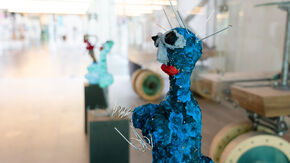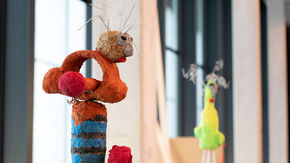Iranian student celebrates female body with solo exhibition
Spiritual and even sacred – that is how people in his home country of Iran view the female body, says architecture student Mazyar Rohani. And that needs to stop, he believes. Now that he is studying in the Netherlands, he feels free to convey that message loud and clear through his art. Today, he will open his solo exhibition in Vertigo, featuring papier-mâché sculptures of women.
This marks the first time that Vertigo will host a solo exhibition. Rohani was given the freedom to shape it as he saw fit. As of next week, fifteen colorful female forms will be on display at the top of the stairwell: the “Descendants of Venus”. For both the figures and the name of the exhibition, the student drew inspiration from the Venus of Willendorf, a small female figurine dating back some 25,000 years. “I was fascinated by the figurine’s primitive forms and simplicity.”
By incorporating these same features into his work, he wants to show how “normal” the female body really is. “In my culture, the female body is always considered sacred and spiritual. But a body is just a body, whether it belongs to a man or a woman. With the toxic masculinity prevalent in Iran, women are manipulated into believing that their bodies must be covered up and guarded. It’s time for that to stop.” That’s not an easy task, he knows, because gender inequality is deeply rooted in Iranian culture.
Fundamental change
According to Rohani, the reason this is so difficult to overcome is because there is widespread support for the Islamic Republic. ‘If you’re a man in Iran, you have all the rights and power. Why would you give that up? Women, on the other hand, aren’t even allowed to attend a soccer match; and unlike men, they can’t file for divorce. Something needs to change fundamentally.”
Femininity deserves to be celebrated, Rohani believes. The women he has encountered throughout his life have left a deep impression on him. Especially his mother. “I was raised by an ‘awakened’ and wise mother; she was far ahead of her time. I inherited the lighter side of my personality from her, as well as my sense of aesthetics.” Three years ago, he lost her – a loss that left a deep void. “The person who brought kindness, motivation and enthusiasm into my life every day is gone. But I cherish the impact she and other women have had on my life, and this exhibit is a celebration of that.”
So it’s no wonder that the sculptures are bursting with cheerful colors. The forms are made of papier-mâché, including material from egg cartons given to him by fellow students. It’s the first time Rohani has worked with this material. He learned how to work with it just before he moved to Eindhoven for his master’s program. “I took a workshop with a friend of mine. The first sculpture I made was very exotic, and it came about almost by accident. But the result was beautiful. I promised myself that once I’d settled in the Netherlands, I would set up an exhibition with these kinds of sculptures.”
Free
In the attic of a friend of his father’s, who has lived in Eindhoven for more than 45 years, Rohani spent eight months working on his sculptures. Jars, glasses; he saw potential art pieces in everything around him. When he approached the coordinator of the exhibition spaces in Vertigo, his collection was still in its infancy. “At that point, all I had were the skeletons of some of the sculptures. Still, he said: go for it. It’s a great opportunity for me and I’m grateful for all the support I’ve received from the TU/e community.”
Thanks to this support and the stimulating environment of the campus, Rohani feels free to infuse his art with emotion. “I could also have created this collection in Iran, and I could probably even exhibit my art in some places. But I would have to hide the actual message behind it.” Rohani says that as an artist in Iran, it is impossible to express your emotions through your art due to the restrictions of the regime and society. “But here, I can talk about it and really turn it into a manifesto – that’s worth a lot to me.”
The exhibition will be on during the whole week, in the trappenzaal of Vertigo.
![[Translate to English:]](/fileadmin/_processed_/9/a/csm_MazyarRohani-LA_4b085e46c6.jpg)



Discussion